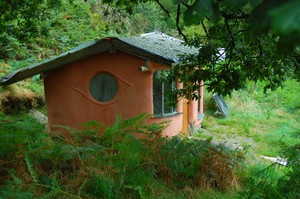What is Cob?
Earth is probably still the world’s commonest building material. The word cob comes from an old English root meaning a lump or rounded mass. Cob building uses hands and feet to form lumps of earth mixed with sand and straw. Cob is easy to learn and inexpensive to build. Because there are no forms, ramming, cement or rectilinear bricks, cob lends itself to organic shapes: curved walls, arches and niches. Earth homes are cool in summer, warm in winter. Cob’s resistance to rain and cold makes it ideally suited to all climates.
Cob has been used for millennia even in the harsh climates of coastal Britain and Ireland. Thousands of comfortable and picturesque cob homes in England have been continuously occupied for many centuries and now command very high market values. With recent rises in the price of lumber and increasing interest in natural and environmentally safe building practices, cob is enjoying a renaissance. This ancient technology doesn’t contribute to deforestation, pollution or mining nor depend on manufactured materials or power tools. Earth is non-toxic and completely recyclable. In this age of environmental degradation, dwindling natural resources, and chemical toxins hidden in our homes, it makes sense to return to nature’s most abundant, cheap and healthy building material.

Why doesn’t it wash away in the rain? Cob is very resistant to weathering. Because of its porous nature, it withstands long periods of rain without weakening. However, too much exposure is best avoided by the “boots and hat” strategy: wide roof eaves to protect the walls and an impervious foundation. In windy areas a lime-sand plaster is traditionally used to protect exterior cob walls from driving rain.
What about earthquakes?
No building system is earthquake proof under every seismic condition, but part of the Great Pyramids and the Great Wall of China are made of earth. The oldest inhabited structure in the U.S., Taos Pueblo, is earthen construction. A cob mansion in Nelson, New Zealand has survived without a crack, two major earthquakes which destroyed the town around it. In South Yemen, in a fault zone, there are Medieval earthen houses 13 stories high. Since a cob building is one monolithic unit reinforced by straw, it has no weak straight-line mortar joints, making it stronger than brick or block.
This link will bring you to a video that shows earthquake tests carried out on a cob building using a shake table test in a laboratory.
Isn’t it cold and damp inside?
Winter visitors to our cob buildings in Ireland often comment on how warm and dry they feel. Cob walls one to two feet thick provide immense thermal mass and adequate insulation, ideal for passive solar construction. Cob structures require little additional heating in winter and remain cool and comfortable on hot summer days. As it is fireproof, cob can be used for building ovens, stoves and chimneys.
How fast can I build with cob? The rate of building depends on weather and the size of your workforce; in dry weather we build up to a foot of height per day. In wood construction, the frame is a tiny part of the work, but a cob wall once built is finished apart from the plaster. Pipes and wires are laid directly in place and there’s no need for plaster board, tape, sanding, painting, sheathing, or vapour barriers. But racing to build fast is missing the point and half the fun. Unlike conventional modern building with its frenetic pace, power tools, and scope for errors and accidents, cob-making is a peaceful, meditative and rhythmic exercise. Building cob is easier and more enjoyable with a crew, so it lends itself to community projects, building parties and workshops.
What does a cob house cost? Cob is one of the cheapest building materials imaginable. Often the soil removed during site work is enough to build the walls. The owner-builder can supply the labour, inviting friends to join in the excitement of hand sculpting a house. With inventiveness and forethought, the costs of other components (doors, windows, roof, floors, etc.) can be extensively reduced.

Does cob building require an expert? Absolutely not! Once the basics are understood, cob building is amazingly simple. In a week long workshop you can learn how to select materials, prepare a mix, and build a wall. We can teach you everything you need to build your cob cottage: site selection, foundations, windows and doors, attachment of wood and other materials, detail work and finishing. Many course graduates with no previous building experience leave our workshops feeling confident and enthusiastic about building their own cob cottage.
How can I learn more about cob? The only proven way to learn about cob building is to try it. The Hollies Centre for Practical Sustainability offers hands-on cob construction workshops in Ireland. Contact us for our current schedule. For in depth reading, we recommend ‘The Handsculpted House’ by Ianto Evans, Linda Smiley and Michael Smith
